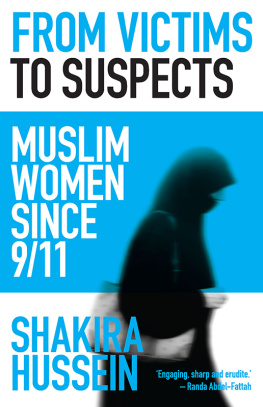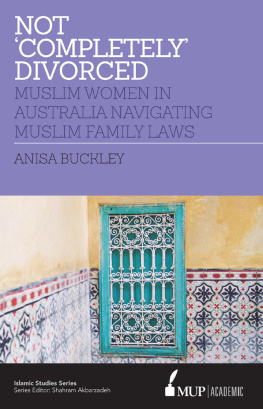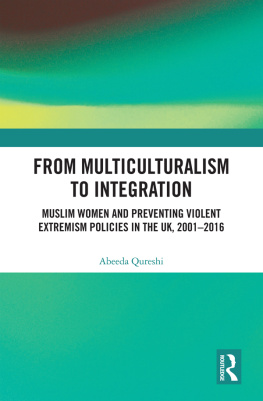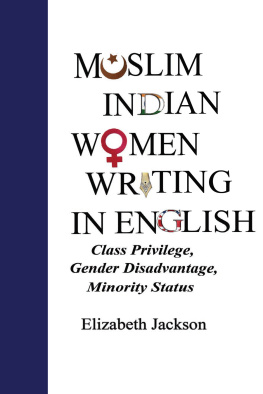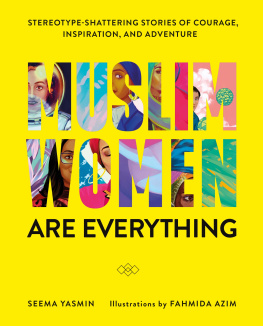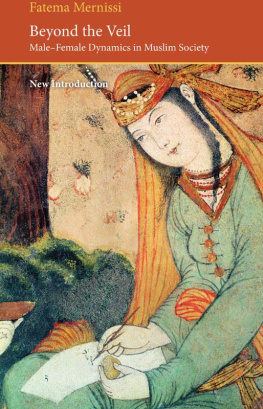FROM VICTIMS TO SUSPECTS
S HAKIRA H USSEIN is a research fellow at The University of Melbournes Asia Institute. She is also a regular commentator on issues of gender, Islam and multiculturalism in Australia. Her essay about her experiences of post-9/11 Pakistan and her multiple sclerosis, Nine-elevenitis, was selected for inclusion in The Best Australian Essays 2011.
For my daughter, Adalya Nash-Hussein
FROM VICTIMS TO SUSPECTS
MUSLIM WOMEN SINCE 9/11
SHAKIRA HUSSEIN

A NewSouth book
Published by
NewSouth Publishing
University of New South Wales Press Ltd
University of New South Wales
Sydney NSW 2052
AUSTRALIA
newsouthpublishing.com
Shakira Hussein 2016
First published 2016
This book is copyright. Apart from any fair dealing for the purpose of private study, research, criticism or review, as permitted under the Copyright Act, no part of this book may be reproduced by any process without written permission. Inquiries should be addressed to the publisher.
National Library of Australia
Cataloguing-in-Publication entry
Creator: Hussein, Shakira, author.
Title: From victims to suspects: Muslim women since 9/11 / Shakira Hussein.
ISBN: 9781742231204 (paperback)
9781742242224 (ebook)
9781742247564 (ePDF)
Notes: Includes bibliographical references.
Subjects: Muslim women Australia History.
Muslim women Australia Social conditions.
War on Terrorism, 20012009.
Dewey Number: 305.48697
Cover design Xou Creative
Cover images iStockphoto
All reasonable efforts were taken to obtain permission to use copyright material reproduced in this book, but in some cases copyright could not be traced. The author welcomes information in this regard.

Contents
Introduction
In February 2001, an 18 000-strong crowd gathered at Madison Square Garden for a gala benefit performance of Eve Enslers The Vagina Monologues. Audience members had paid up to $1000 a ticket to see stars like Jane Fonda, Brooke Sheilds and Gloria Steinem read Enslers work, recite pet names for their vaginas, and join Glenn Close in a chant of Cunt! Cunt! On stage, talk-show host Oprah Winfrey recited Under the Burqa, a new poem that Ensler had written especially for the occasion:
imagine a huge dark piece of cloth
hung over your entire body
like you were a shameful statue
Then the stadium went dark to throw the spotlight on Zoya, a young member of the Revolutionary Association of the Women of Afghanistan, clad in the burqa she had brought to New York at Enslers request. Zoya later described how the blinding spotlight brought tears to her eyes as she slowly made her way onstage, where [s]lowly, very slowly, Oprah lifted the burqa off me and let it fall to the stage. Zoyas speech about Taliban oppression of women in Afghanistan received a standing ovation from the audience.
The burqa-clad woman in the photo circulated by Australian Senator Jacqui Lambie in September 2014 does not look like a shameful statue waiting to be unveiled. Like the woman in Enslers poem, she is swathed in a huge piece of cloth, but she stands straight and tall, a string of prayer beads hanging from her wrist as she points a pistol towards an unseen target. And she is not about to receive a standing ovation. Rather, the image, which originated from the Facebook page of the right-wing anti-immigration party Britain First was emblazoned with the message Terror attack level Severe: an attack is highly likely. For security reasons, its now time to ban the burqa.
Embarrassingly for Lambie, the woman in the photograph turned out to be not a dangerous terrorist, but a heroine of law and order. Afghan policewoman Malalai Kakar had worn the burqa to conceal her identity in the course of her work combating violence against women, until she herself was murdered by the Taliban in 2008. Photographer Lana Slezic described Lambies use of her work as insensitive and frankly stupid and noted that [Kakar] was the pinnacle of strength in Kandahar at a time that was extremely difficult for Afghan women. She was the first female police officer in Kandahar and stood for the rights of women. Lambie unconvincingly claimed to have known this all along. Malalai Kakar would have been the first to agree with my call to ban the burka. Far from desecrating her memory, my facebook post honours her and the deadly struggle against brutal thugs and extremists.
How has the woman beneath the burqa been transformed from a helpless victim unable to cast off her own shroud into a menacing terrorist who must be brought under control for security reasons?
Orientalist discussions on gender and Islam have long fluctuated between portrayals of Muslim women as hapless victims in need of rescue and as dangerous agents of an alien ideology in need of discipline a pattern that has become more pronounced during the post-9/11 era. As the Taliban retreated from Kabul in 2001, the sought-after media money-shot was that of liberated Afghan women casting off their hated burqas. By the time Jacqui Lambie posted the image of Malalai Kakar, the narrative had shifted from the forcible imposition of burqas in Afghanistan to the introduction of state-imposed burqa-prohibition in European states including France, Belgium and the Netherlands. This modification in attitudes towards the burqa reflects a shift in representations of Muslim women from that of passive victims in their own societies and communities to active participants in Islamism and the Islamisation of the West. Unruly Muslim women must, it seems, be controlled not only in order to liberate them from their own false consciousness, but also in order to contain the threat they pose to Western societies.
Muslim women as victims
In November 2001, nine months after Zoyas ritualised unveiling in Madison Square Garden, United States First Lady Laura Bush made a now-famous radio address to the nation in a slot usually occupied by her husband. Her purpose, she announced was:
to kick off a worldwide effort to focus on the brutality against women and children by the Al Qaeda terrorist network and the regime it supports in Afghanistan, the Taliban.
That regime is now in retreat across much of the country, and the people of Afghanistan, especially women, are rejoicing. Afghan women know through hard experience what the rest of the world is discovering: The brutal oppression of women is a central goal of the terrorists.
Laura Bushs speech in support of Afghan women was part of the effort to broaden the focus of American retaliation to include the Taliban as well as al-Qaeda. But it also served as a mission statement for the plethora of subsequent operations to rescue Muslim women not only in Afghanistan, but also throughout the Muslim world and in Muslim communities in the West. The so-called War on Terror, in all its many incarnations, was to be a war with gender at its heart.
Lila Abu-Lughod, a professor of anthropology at Columbia University whose work focuses on the issues of power and womens rights in the Middle East, has described how in the weeks following the First Ladys speech she was deluged with enquires from journalists asking her to use her knowledge of gender and Islam to explain the unfolding conflict:
Instead of political and historical questions, experts were being asked to give religious or cultural ones. Instead of questions that might lead to the examination of internal political struggles among groups in Afghanistan, or of global interconnections between Afghanistan and other nation-states, we were offered ones that worked to artificially divide the world into separate spheres re-creating an imaginative geography of West versus East, us versus Muslims cultures in which first ladies give speeches versus others in which women shuffle around silently in burqas.
Next page
